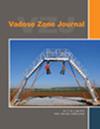Modeling sub‐resolution porosity of a heterogeneous carbonate rock sample
IF 2.8
3区 地球科学
Q3 ENVIRONMENTAL SCIENCES
引用次数: 0
Abstract
Accurately estimating the petrophysical properties of heterogeneous carbonate rocks across various scales poses significant challenges, particularly within the context of water and hydrocarbon reservoir studies. Digital rock analysis techniques, such as X‐ray computed microtomography and synchrotron‐light‐based imaging, are increasingly employed to study the complex pore structure of carbonate rocks. However, several technical limitations remain, notably the need to balance the volume of interest with the maximum achievable resolution, which is influenced by geometric properties of the source–detector distance in each apparatus. Typically, higher resolutions necessitate smaller sample volumes, leading to a portion of the pore structure (the sub‐resolution or unresolved porosity), that remain undetected. In this study, X‐ray microtomography is used to infer the fluid flow properties of a carbonate rock sample having a substantial fraction of porosity below the imaging resolution. The existence of unresolved porosity is verified by comparisons with nuclear magnetic resonance (NMR) data. We introduce a methodology for modeling the sub‐resolution pore structure within images by accounting for unresolved pore bodies and pore throats derived from a predetermined distribution of pore throat radii. The process identifies preferential pathways between visible pores using the shortest distance and establishes connections between these pores by allocating pore bodies and throats along these paths, while ensuring compatibility with the NMR measurements. Single‐phase flow simulations are conducted on the full volume of a selected heterogeneous rock sample by using the developed pore network model. Results are then compared with petrophysical data obtained from laboratory measurements.异质碳酸盐岩样本的亚分辨率孔隙度建模
准确估算不同尺度异质碳酸盐岩的岩石物理特性是一项重大挑战,尤其是在水和碳氢化合物储层研究方面。在研究碳酸盐岩复杂的孔隙结构时,人们越来越多地采用数字岩石分析技术,如 X 射线计算机显微层析技术和同步辐射成像技术。然而,仍然存在一些技术限制,特别是需要在感兴趣的体积与可实现的最大分辨率之间取得平衡,而这受到每台仪器的源-探测器距离的几何特性的影响。通常情况下,分辨率越高,样品体积就越小,从而导致部分孔隙结构(次分辨率或未解决的孔隙度)仍未被探测到。在本研究中,X 射线显微层析成像技术被用于推断碳酸盐岩样本的流体流动特性,该样本中的大部分孔隙度低于成像分辨率。通过与核磁共振(NMR)数据进行比较,验证了未解决孔隙度的存在。我们介绍了一种方法,通过考虑未解决的孔体和孔喉半径预定分布得出的孔喉,对图像中的亚分辨率孔隙结构进行建模。该过程使用最短距离识别可见孔隙之间的优先路径,并通过沿这些路径分配孔体和孔喉建立这些孔隙之间的连接,同时确保与核磁共振测量的兼容性。利用所开发的孔隙网络模型,对所选异质岩石样本的整个体积进行单相流模拟。然后将结果与实验室测量获得的岩石物理数据进行比较。
本文章由计算机程序翻译,如有差异,请以英文原文为准。
求助全文
约1分钟内获得全文
求助全文
来源期刊

Vadose Zone Journal
环境科学-环境科学
CiteScore
5.60
自引率
7.10%
发文量
61
审稿时长
3.8 months
期刊介绍:
Vadose Zone Journal is a unique publication outlet for interdisciplinary research and assessment of the vadose zone, the portion of the Critical Zone that comprises the Earth’s critical living surface down to groundwater. It is a peer-reviewed, international journal publishing reviews, original research, and special sections across a wide range of disciplines. Vadose Zone Journal reports fundamental and applied research from disciplinary and multidisciplinary investigations, including assessment and policy analyses, of the mostly unsaturated zone between the soil surface and the groundwater table. The goal is to disseminate information to facilitate science-based decision-making and sustainable management of the vadose zone. Examples of topic areas suitable for VZJ are variably saturated fluid flow, heat and solute transport in granular and fractured media, flow processes in the capillary fringe at or near the water table, water table management, regional and global climate change impacts on the vadose zone, carbon sequestration, design and performance of waste disposal facilities, long-term stewardship of contaminated sites in the vadose zone, biogeochemical transformation processes, microbial processes in shallow and deep formations, bioremediation, and the fate and transport of radionuclides, inorganic and organic chemicals, colloids, viruses, and microorganisms. Articles in VZJ also address yet-to-be-resolved issues, such as how to quantify heterogeneity of subsurface processes and properties, and how to couple physical, chemical, and biological processes across a range of spatial scales from the molecular to the global.
 求助内容:
求助内容: 应助结果提醒方式:
应助结果提醒方式:


